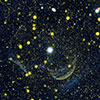Feature Story
GALEX Searches for Milky Way's Missing White Dwarfs
Astronomers have long suspected that the glowing embers of dying stars, once more massive than our Sun, may hold valuable clues about the origins and inner workings of our Milky Way galaxy. The only problem is finding them.
Like celestial "ghosts," these shimmering stellar cinders -- called white dwarfs -- lurk virtually undetected among the galaxy's optically bright stars. Most stars we see in the night sky glow brilliantly in visible-light, which our eyes sense. But, white dwarfs shine brightest in the ultraviolet -- a light that is invisible to the human eye, and almost completely blocked by the Earth's atmosphere. This makes them very difficult to detect with ground-based telescopes.
Now, scientists are hoping that the ultraviolet eyes of NASA's space-based Galaxy Evolution Explorer (GALEX) can help isolate the Milky Way galaxy's white dwarfs from the crowd of stars that visibly outshine them.
"This work will provide an unprecedented census of the [Milky Way galaxy's] small incandescent white dwarfs," said Dr. Luciana Bianchi of Johns Hopkins University, Baltimore, Md.
HOW DOES A STAR BECOME WHITE DWARF?
Typically, medium mass stars -- or stars like our Sun, and those that are a little more massive -- become white dwarfs when they die.
These stars spend most of their lives producing energy, by fusing the hydrogen atoms in their cores into other chemical elements. Our Sun is currently doing this. Once the stars run out of hydrogen, they will expand to become "red-giant" stars. Eventually, the red giant will shed its external layers, exposing a dense hot core, about the size of Earth known as a "white dwarf."
Since the stars spend the majority of their lives fusing hydrogen atoms into heavier elements, the left over core -- or white dwarf -- is incredibly dense. This Earth-size ball contains between half to almost one solar mass. Bianchi likens this to crushing a small compact car into a sugar cube.
"Because of their small dimensions and hot surface, white dwarfs appear like dim stars in visible-light images, and are undistinguishable from other dim stars," said Bianchi.
REVEALING WHITE DWARFS
Most of the time, astronomers can isolate and classify stars according to their temperature.
By placing different colored filters onto a visible-light telescope, scientists can tell how hot a star is. For example, stars like our Sun shine brightest in green and yellow filters. Meanwhile, relatively cool stars will glow brightly in red filters, and the hottest stars will show up when the filter is blue.
According to Bianchi, this technique is not extremely helpful in detecting white dwarfs because stars that are 25,000 Kelvin (24,726 Celsius, 44,540 Fahrenheit) and hotter all look the same in blue filters. This makes it extremely difficult to pick out the white dwarfs, whose temperatures can soar well above 100,000 Kelvin (99,726 Celsius, 179,540 Fahrenheit), from the sea of other hot stars.
"Finding white dwarfs in astronomical images at optical wavelengths is like finding a needle in a hay-stack... In every square degree of sky, there may be one white dwarf and thousands of other normal stars," said Bianchi.
This is where GALEX comes in handy. On Earth, astronomers have trouble finding white dwarfs because the extremely hot ultraviolet light that they emit is blocked by the Earth's atmosphere. However, because GALEX is a space-based observatory -- flying high above the Earth's atmosphere -- it can sense ultraviolet light before the atmosphere filters it.
According to Bianchi, GALEX's sensitivity to the ultraviolet light range helps to effortlessly detect the galaxy's hottest stars. In GALEX images all the cool stars that are usually bright from the ground, seem very faint or even invisible. Meanwhile the stars that shine primarily ultraviolet light, which we don't normally see, glow brightly.
"This is how we basically find, not one, but almost all the 'needles in the hay-stack,' or white dwarfs in the Milky Way galaxy," said Bianchi.
According to her calculations, GALEX's sensitivity and wide field of view should help astronomers detect most of the white dwarfs hiding in the halo, or outskirts, of our galaxy.
"Collecting and studying all the 'needles of the hay stack' is not just a curiosity, it may solve some important [questions] about stellar evolution, specifically about the final phases of a star's life," Bianchi adds.
CLUES ABOUT OUR GALAXY'S PAST, PRESENT, AND FUTURE
With a comprehensive census of our Milky Way galaxy's white dwarfs, astronomers say great strides could be made in understanding how our galaxy has evolved over time, and its current structure.
Because our solar system sits inside the Milky Way galaxy, it's hard to know what the galaxy looks like from the outside. Astronomers have to discern the structure of our galaxy by looking at how the stars inside of it are distributed.
"Stellar counts delineate the galactic structure, and having a census of all distinct stellar populations and their kinematics [or movements], is needed to understand how the Milky Way formed and its present structure," said Bianchi.
She also notes that understanding the final phases of a medium mass star's life may yield clues to finding out where chemicals, including those that made life possible, came from. All chemical elements heavier than hydrogen and helium are born inside stars. When these stars die, they unleash these elements into the cosmos. Eventually these elements may get trapped inside another star, or in a planet and play an important role in supporting life.
"If we miss this population, then we miss a most important element to trace back Milky Way's evolution, to understand the chemical evolution of the Milky Way, and stellar evolution," said Bianchi.




